Increasing Light-Induced Forces with Magnetic Photonic Glasses
Abstract
:1. Introduction
2. Materials and Methods
2.1. Preparation of MPGs
2.2. MPGs Characterization
2.3. FEM Numerical Simulations
2.4. Mechanical Oscillations Theoretical Model
3. Results
3.1. Scanning Electron Microscopy
3.2. Magnetic Characterization
3.3. Optical Characterization
3.4. Mechanical Oscillations Measurements
3.5. FEM Numerical Simulations
3.6. Mechanical Oscillations Theoretical Model
4. Discussion
5. Conclusions
Author Contributions
Funding
Institutional Review Board Statement
Informed Consent Statement
Data Availability Statement
Conflicts of Interest
References
- Joannopoulos, J.D.; Johnson, S.G.; Winn, J.N.; Meade, R.D. Photonic Crystals Molding the Flow of Light; Princeton University Press: Princeton, NJ, USA; Oxford, UK, 2008. [Google Scholar]
- Lugo, J.E.; Lopez, H.A.; Chan, S.; Fauchet, P.M.J. Porous silicon multilayer structures: A photonic band gap analysis. Appl. Phys. 2002, 91, 4966–4972. [Google Scholar] [CrossRef]
- Fink, Y.; Winn, J.N.; Fan, S.; Chen, C.; Michel, J.; Joannopoulos, J.D.; Thomas, E.L. A dielectric omni-directional reflector. Science 1998, 282, 1679. [Google Scholar] [CrossRef] [PubMed]
- Agarwal, V.; del Río, J.A.; Malpuech, G.; Zamfirescu, M.; Kavokin, A.; Coquillat, D.; Scalbert, D.; Vladimirova, M.; Gil, B. Photon Bloch oscillations in porous silicon optical superlattices. Phys. Rev. Lett. 2004, 92, 097401. [Google Scholar] [CrossRef]
- Estevez, J.O.; Arriaga, J.A.; Mendez-Blas, A.; Reyes-Ayona, E.; Escorcia, J.; Agarwal, V. Demonstration of photon Bloch oscillations and Wannier-Stark ladders in dual-periodical multilayer structures based on porous silicon. Nanoscale Res. Lett. 2012, 7, 413. [Google Scholar]
- Rodriguez, G.A.; Lawrie, J.L.; Weiss, S.M. Porous Silicon Biosensors for DNA Sensing, Porous Silicon for Biomedical Applications; Santos, H.A., Ed.; Woodhead Publishing Ltd.: Sawston, UK; University of Helsinki: Helsinki, Finland, 2014. [Google Scholar]
- Lugo, J.E.; Doti, R.; Faubert, J. Negative refraction angular characterization in one-dimensional photonic crystals. PLoS ONE 2011, 6, e17188. [Google Scholar] [CrossRef]
- John, S. Strong localization of photons in certain disordered dielectric superlattices. Phys. Rev. Lett. 1987, 58, 2486. [Google Scholar] [CrossRef] [PubMed]
- Wu, F.; Lu, G.; Guo, Z.; Jiang, H.; Xue, C.; Zheng, M.; Chen, C.; Du, G.; Chen, H. Redshift gaps in one-dimensional photonic crystals containing hyperbolic metamaterials. Phys. Rev. Appl. 2018, 10, 064022. [Google Scholar] [CrossRef]
- Wu, F.; Liu, T.; Xiao, S. Polarization-sensitive photonic bandgaps in hybrid one-dimensional photonic crystals composed of all-dielectric elliptical metamaterials and isotropic dielectrics. Appl. Opt. 2023, 62, 706–713. [Google Scholar] [CrossRef]
- Park, J.M.; Gan, Z.; Leung, W.Y.; Liu, R.; Ye, Z.; Constant, K.; Shinar, J.; Shinar, R.; Ho, K.-M. Soft holographic interference lithography microlens for enhanced organic light emitting diode light extraction. Opt. Express 2011, 19, A786–A792. [Google Scholar] [CrossRef] [PubMed]
- Matsubara, H.; Yoshimoto, S.; Saito, H.; Jianglin, Y.; Tanaka, Y.; Noda, S. GaN photonic-crystal surface-emitting laser at blue-violet wavelengths. Science 2008, 319, 445–447. [Google Scholar] [CrossRef]
- Boroditsky, M.; Krauss, T.F.; Coccioli, R.; Vrijen, R.; Bhat, R.; Yablonovitch, E. Light extraction from optically pumped light-emitting diode by thin-slab photonic crystals. Appl. Phys. Lett. 1999, 75, 1036–1038. [Google Scholar] [CrossRef]
- Nelson, E.C.; Dias, N.L.; Bassett, K.P.; Dunham, S.N.; Verma, V.; Miyake, M.; Wiltzius, P.; Rogers, J.A.; Coleman, J.J.; Li, X.; et al. Epitaxial growth of three-dimensionally architectured optoelectronic devices. Nat. Mater. 2011, 10, 676–681. [Google Scholar] [CrossRef]
- Lin, S.Y.; Moreno, J.; Fleming, J.G. Three-dimensional photonic-crystal emitter for thermal photovoltaic power generation. Appl. Phys. Lett. 2003, 83, 380–382. [Google Scholar] [CrossRef]
- Yablonovitch, E. One-way road for light. Nature 2009, 461, 744–745. [Google Scholar] [CrossRef]
- Wang, Z.; Chong, Y.; Joannopoulos, J.D.; Soljai, M. Observation of unidirectional backscattering-immune topological electromagnetic states. Nature 2009, 461, 772–775. [Google Scholar] [CrossRef] [PubMed]
- Takahashi, K.; Kawanishi, F.; Mito, S.; Takagi, H.; Shin, K.H.; Kim, J.; Inoue, M. Study on magnetophotonic crystals for use in reflection-type magneto-optical spatial light modulators. J. Appl. Phys. 2008, 103, 07B331. [Google Scholar] [CrossRef]
- Boriskina, J.V.; Erokhin, S.G.; Granovsky, A.B.; Vinogradov, A.P.; Inoue, M. Enhancement of the magnetorefractive effect in magnetophotonic crystals. Phys. Solid State 2006, 48, 717–721. [Google Scholar] [CrossRef]
- Fedyanin, A.A.; Aktsipetrov, O.A.; Kobayashi, D.; Nishimura, K.; Uchida, H.; Inoue, M. Enhanced Faraday and nonlinear magneto-optical Kerr effects in magnetophotonic crystals. J. Magn. Magn. Mater. 2004, 282, 256–259. [Google Scholar] [CrossRef]
- Lyubchanskii, L.; Dadoenkova, N.N.; Lyubchanskii, M.I.; Shapovalov, E.A.; Rasing, T. Magnetic photonic crystals. J. Phys. D Appl. Phys. 2003, 36, R277. [Google Scholar] [CrossRef]
- Inoue, M.; Fujikawa, R.; Baryshev, A.; Khanikaev, A.; Lim, P.B.; Uchida, H.; Aktsipetrov, O.; Fedyanin, A.; Murzina, T.; Granovsky, A. Magnetophotonic crystals. J. Phys. D Appl. Phys. 2006, 39, R151. [Google Scholar] [CrossRef]
- Zhang, H.F.; Liu, S.B.; Kong, X.K.; Li, B.X. Photonic band gap of three dimensional magnetized photonic crystal with Voigt configuration. Eur. Phys. J. 2013, 67, 169. [Google Scholar] [CrossRef]
- Bahlmann, N.; Lohmeyer, M.; Zhuromskyy, O.; Dotsch, H.; Hertel, P. Nonreciprocal coupled waveguides for integrated optical isolators and circulators for TM-modes. Opt. Commun. 1999, 161, 330. [Google Scholar] [CrossRef]
- Gevorgyan, A.H.; Golik, S.S.; Gevorgyan, T.A. Diode based on magneto-photonic crystals. J. Magn. Magn. Mater. 2019, 474, 173. [Google Scholar] [CrossRef]
- Chen, J.; Liang, W.; Li, Z.Y. Strong coupling of topological edge states enabling group-dispersionless slow light in magne-to-optical photonic crystals. Phys. Rev. B 2019, 99, 014103. [Google Scholar] [CrossRef]
- Sheng, P. Introduction to Wave Scattering, Localization, and Mesoscopic Phenomena; Academic Press: San Diego, CA, USA, 1995. [Google Scholar]
- van Albada, M.P.; van Tiggelen, B.A.; Lagendijk, A.; Tip, A. Speed of propagation of classical waves in strongly scattering media. Phys. Rev. Lett. 1991, 66, 3132. [Google Scholar] [CrossRef]
- Gottardo, S.; Sapienza, R.; Garcia, P.D.; Blanco, A.; Wiersma, D.S.; Lopez, C. Resonance-driven random lasing. Nat. Photonics 2008, 2, 429. [Google Scholar] [CrossRef]
- Schertel, L.; Siedentop, L.; Meijer, J.M.; Keim, P.; Aegerter, C.M.; Aubry, G.J.; Maret, G. The structural colors of photonic glasses. Adv. Opt. Mater. 2019, 7, 1900442. [Google Scholar] [CrossRef]
- Schertel, L.; Wimmer, I.; Besirske, P.; Aegerter, C.M.; Maret, G.; Polarz, S.; Aubry, G.J. Tunable high-index photonic glasses. Phys. Rev. Mater. 2019, 3, 015203. [Google Scholar] [CrossRef]
- Ashkin, A. Acceleration and trapping of particles by radiation pressure. Phys. Rev. Lett. 1970, 24, 156. [Google Scholar] [CrossRef]
- Ashkin, A.; Dziedzic, J.M. Optical trapping and manipulation of viruses and bacteria. Science 1987, 235, 1517. [Google Scholar] [CrossRef] [PubMed]
- Boales, J.A.; Mateen, F.; Mohanty, P. Micromechanical resonator driven by radiation pressure force. Sci. Rep. 2017, 7, 1. [Google Scholar] [CrossRef]
- Metzger, C.H.; Karrai, K. Cavity cooling of a microlever. Nature 2004, 432, 1002–1005. [Google Scholar] [CrossRef]
- Wilson-Rae, I.; Nooshi, N.; Zwerger, W.; Kippenberg, T.J. Theory of ground state cooling of a mechanical oscillator using dynamical backaction. Phys. Rev. Lett. 2007, 99, 093901. [Google Scholar] [CrossRef] [PubMed]
- Lugo, J.E.; Doti, R.; Sánchez, N.; de la Mora, M.B.; del Río, J.A.; Faubert, J. The bifoil photodyne: A photonic crystal oscillator. Sci. Rep. 2014, 4, 3705. [Google Scholar] [CrossRef] [PubMed]
- Lugo, J.E.; Doti, R.; Sánchez, N.; Faubert, J. Inducing forced and auto-oscillations in one-dimensional photonic crystals with light. J. Nanophoton. 2014, 8, 083071. [Google Scholar] [CrossRef]
- Sánchez-Castro, N.; Palomino-Ovando, M.A.; Estrada-Wiese, D.; Valladares, N.X.; del Río, J.A.; De la Mora, M.B.; Lugo, J.E. The Influence of the External Signal Modulation Waveform and Frequency on the Performance of a Photonic Forced Oscillator. Materials 2018, 11, 854. [Google Scholar] [CrossRef] [PubMed]
- Xia, J.; Qiao, Q.; Zhou, G.; Chau, F.S.; Zhou, G. Opto-mechanical photonic crystal cavities for sensing application. Appl. Sci. 2020, 10, 7080. [Google Scholar] [CrossRef]
- Matamoros-Ambrocio, M.; Sánchez-Mora, E.; Gómez-Barojas, E.; Luna-López, J.A. Synthesis and study of the optical properties of PMMA microspheres and opals. Polymers 2021, 13, 2171. [Google Scholar] [CrossRef]
- Norris, D.J.; Arlinghaus, E.G.; Meng, L.; Heiny, R.; Scriven, L.E. Opaline photonic crystals: How does self-assembly work? Adv. Mater. 2004, 16, 1393. [Google Scholar] [CrossRef]
- Fudouzi, H.; Xia, Y. Photonic papers and inks: Color writing with colorless materials. Adv. Mater. 2003, 15, 892. [Google Scholar] [CrossRef]
- Huang, C.K.; Chan, C.H.; Chen, C.Y.; Tsai, Y.L.; Chen, C.C.; Han, J.L.; Hsieh, K.H. Rapid fabrication of 2D and 3D pho-tonic crystals and their inversed structures. Nanotechnology 2007, 18, 265305. [Google Scholar] [CrossRef] [PubMed]
- Ye, J.; Zentel, R.; Arpiainen, S.; Ahopelto, J.; Jonsson, F.; Romanov, S.G.; Torres, C.M.S. Integration of self-assembled three-dimensional photonic crystals onto structured silicon wafers. Langmuir 2006, 18, 7378. [Google Scholar] [CrossRef] [PubMed]
- Chan, C.H.; Chen, C.C.; Huang, C.K.; Weng, W.H.; Wei, H.S.; Chen, H.; Lin, H.T.; Chang, H.S.; Chen, W.Y.; Chang, W.H.; et al. Self-assembled free-standing colloidal crystals. Nanotechnology 2005, 16, 1440. [Google Scholar] [CrossRef]
- Cong, H.; Yu, B.J. Fabrication of superparamagnetic macroporous Fe3O4 and its derivates using colloidal crystals as templates. Colloid Interface Sci. 2011, 353, 131. [Google Scholar] [CrossRef]
- Carmona-Carmona, A.J.; Palomino-Ovando, M.A.; Hernández-Cristobal, O.; Sánchez-Mora, E.; Toledo-Solano, M. Synthesis and characterization of magnetic opal/Fe3O4 colloidal crystal. J. Cryst. Growth 2017, 462, 6. [Google Scholar] [CrossRef]
- Romero-Cruz, L.A.; Santos-Gómez, A.; Palomino Ovando, M.A.; Hernández Cristobal, O.; Sánchez Mora, E.; González, A.L.; Toledo Solano, M. Surface enhanced Raman scattering due to interstitial gold nanoparticles into SiO2 spheres array. Superlattices Microstruct. 2018, 123, 71. [Google Scholar] [CrossRef]
- Fang, M.; Volotinen, T.T.; Kulkarni, S.K.; Belova, L.; Rao, K.V. Effect of embedding Fe3O4 nanoparticles in silica spheres on the optical transmission properties of three-dimensional magnetic photonic crystals. J. Appl. Phys. 2010, 108, 103501. [Google Scholar] [CrossRef]
- Shung, K.W.-K.; Tsai, Y.C. Surface effects and band measurements in photonic crystals. Phys. Rev. B 1993, 48, 11265. [Google Scholar] [CrossRef]
- Mansuripur, M. Radiation pressure and the linear momentum of the electromagnetic field in magnetic media. Opt. Express 2007, 15, 13502. [Google Scholar] [CrossRef]
- Sanchez-Seguame, G.; Avalos-Sanchez, H.; Eduardo Lugo, J.; Murillo-Bracamontes, E.A.; Palomino-Ovando, M.A.; Hernández-Cristobal, O.; Gervacio-Arciniega, J.J.; Toledo-Solano, M. Magnetic-Dielectric Cantilevers for Atomic Force Microscopy. Nanomaterials 2024, 14, 874. [Google Scholar] [CrossRef] [PubMed]
- Andronov, A.A.; Vitt, A.A.; Khakin, S.E. Theory of Oscillations, 1st ed.; Princeton University Press: Princeton, NJ, USA, 1949; pp. 102–137. [Google Scholar]
- Jenkins, A. Self-oscillation. Phys. Rep. 2013, 525, 2. [Google Scholar] [CrossRef]
- Rabe, U.; Janser, K.; Arnold, W. Vibrations of free and surface-coupled atomic force microscope cantilevers: Theory and experiment. Rev. Sci. Instruments 1996, 67, 3281. [Google Scholar] [CrossRef]
- Li, H.L.; Dong, W.; Bongard, H.J.; Marlow, F. Improved controllability of opal film growth using capillaries for the deposition process. J. Phys. Chem. B 2005, 109, 9939. [Google Scholar] [CrossRef] [PubMed]
- Kulkarni, S.A.; Sawadh, P.S.; Palei, P.K.; Kokate, K.K. Effect of synthesis route on the structural, optical and magnetic properties of Fe3O4 nanoparticles. Ceram. Int. 2014, 40, 1945. [Google Scholar] [CrossRef]
- Gajiev, G.M.; Golubev, V.G.; Kurdyukov, D.A.; Medvedev, A.V.; Pevtsov, A.B.; Sel‘kin, A.V.; Tranikov, V.V. Bragg reflection spectroscopy of opal-like photonic crystals. Phys. Rev. B 2005, 72, 205115. [Google Scholar] [CrossRef]
- Malitson, I.H. Interspecimen comparison of the refractive index of fused silica. Josa 1987, 55, 1205–1209. [Google Scholar] [CrossRef]
- Aspnes, D.E. Local-field effects and effective-medium theory: A microscopic perspective. Am. J. Phys 1982, 50, 704–709. [Google Scholar] [CrossRef]
- Bruggeman, D.A.G. Berechnung verschiedener physikalischer Konstanten von heterogenen Substanzen. Ann. Phys. 1935, 416, 636. [Google Scholar] [CrossRef]
- Landau, L.D.; Lifshitz, E.M. Electrodynamics of Continuous Media; Pergamon Press: Oxford, UK, 1960. [Google Scholar]
- Miguez, H.; Kitaev, V.; Ozin, G.A. Band spectroscopy of colloidal photonic crystal films. Appl. Phys. Lett. 2004, 84, 1239–1241. [Google Scholar] [CrossRef]
- Sakoda, K. Optical Characteristics of Photonic Crystals; Springer-Verlag: Berlin, Germany, 2001. [Google Scholar]
- Querry, M.R. Optical Constants, 1st ed.; University of Missouri-Kansas City: Kansas City, MO, USA, 1987; p. 17. [Google Scholar]
- Han, R.; Li, W.; Pan, W.; Zhu, M.; Zhou, D.; Li, F.S. 1D magnetic materials of Fe3O4 and Fe with high performance of microwave absorption fabricated by electrospinning method. Sci. Rep. 2014, 4, 7493. [Google Scholar] [CrossRef]
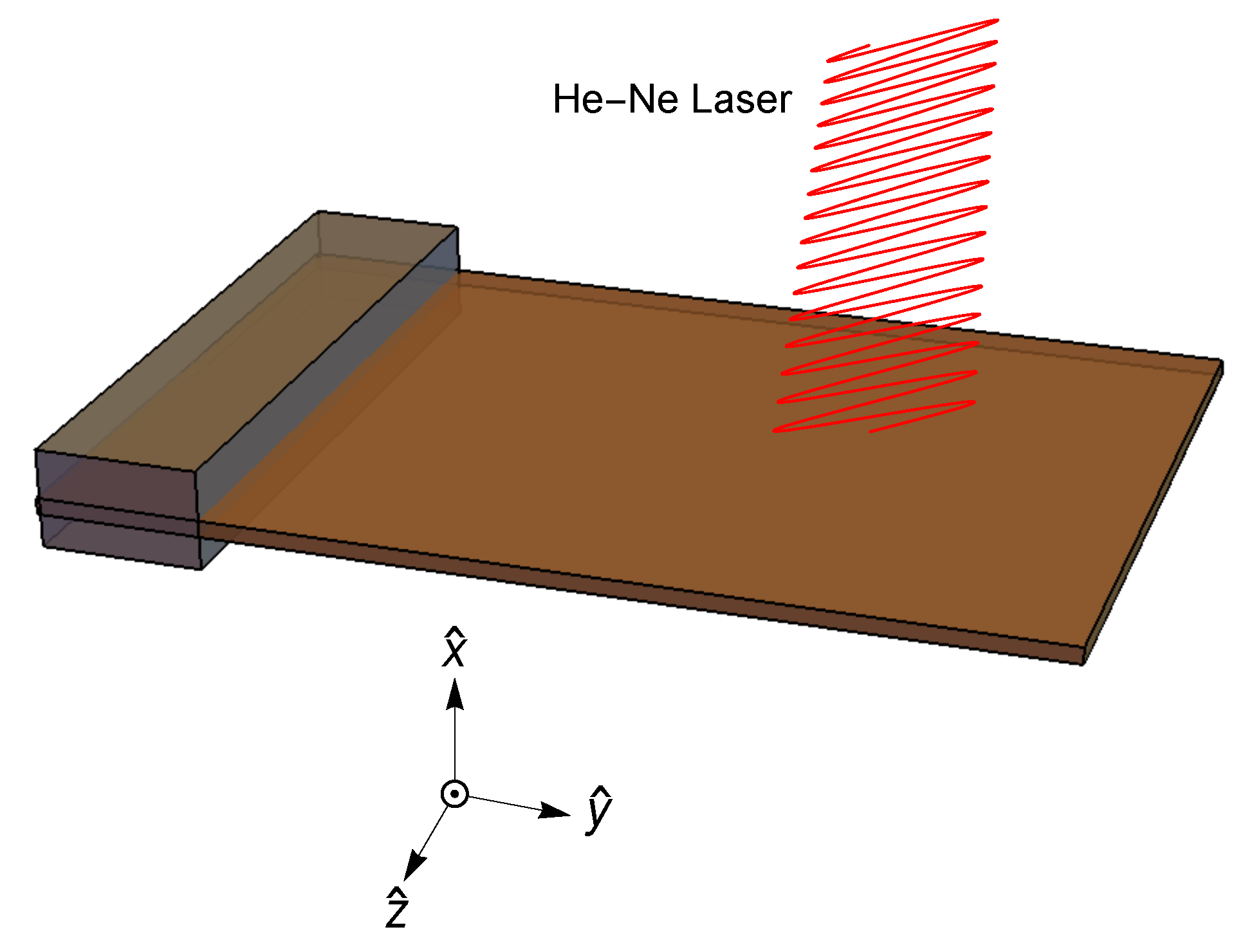
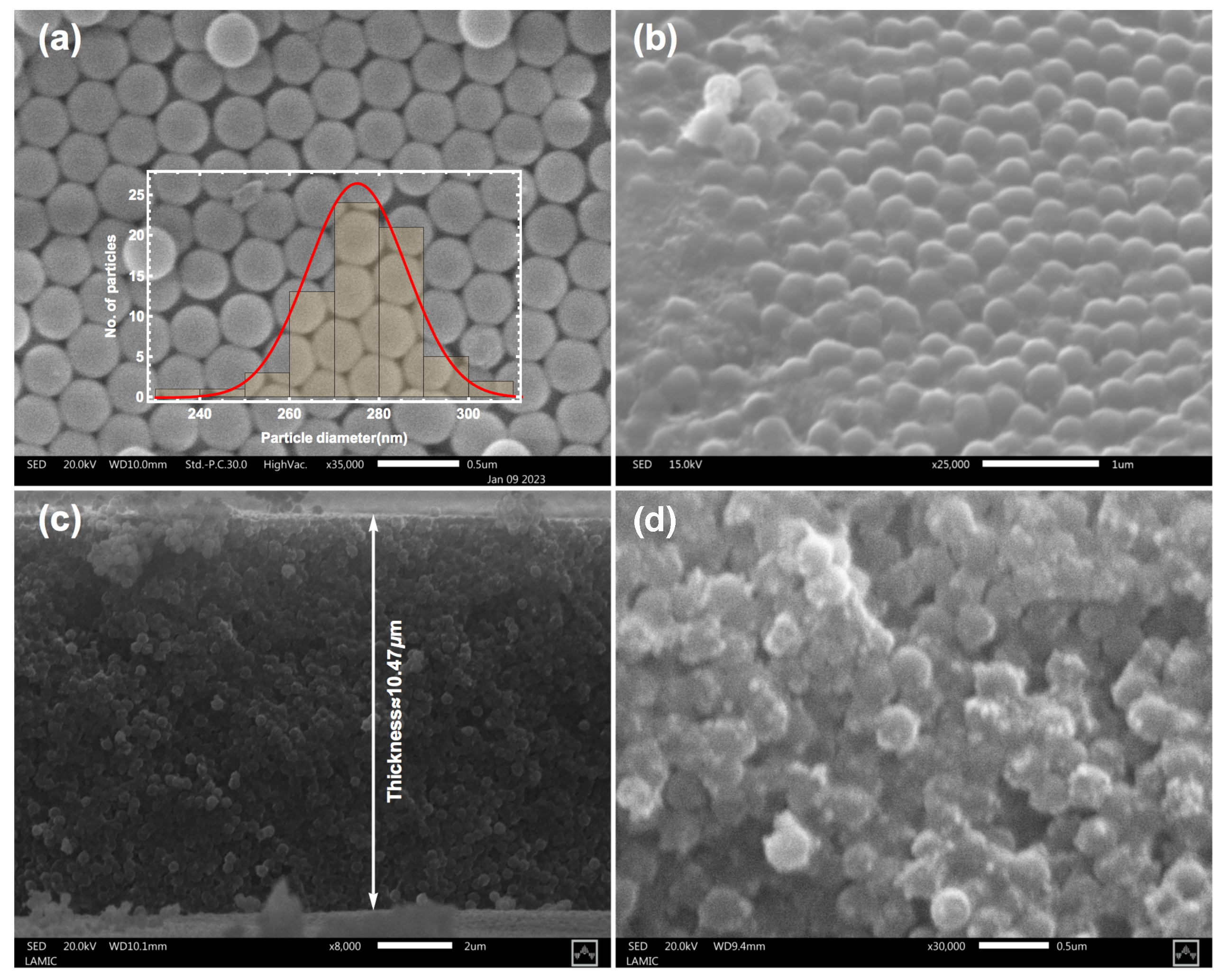
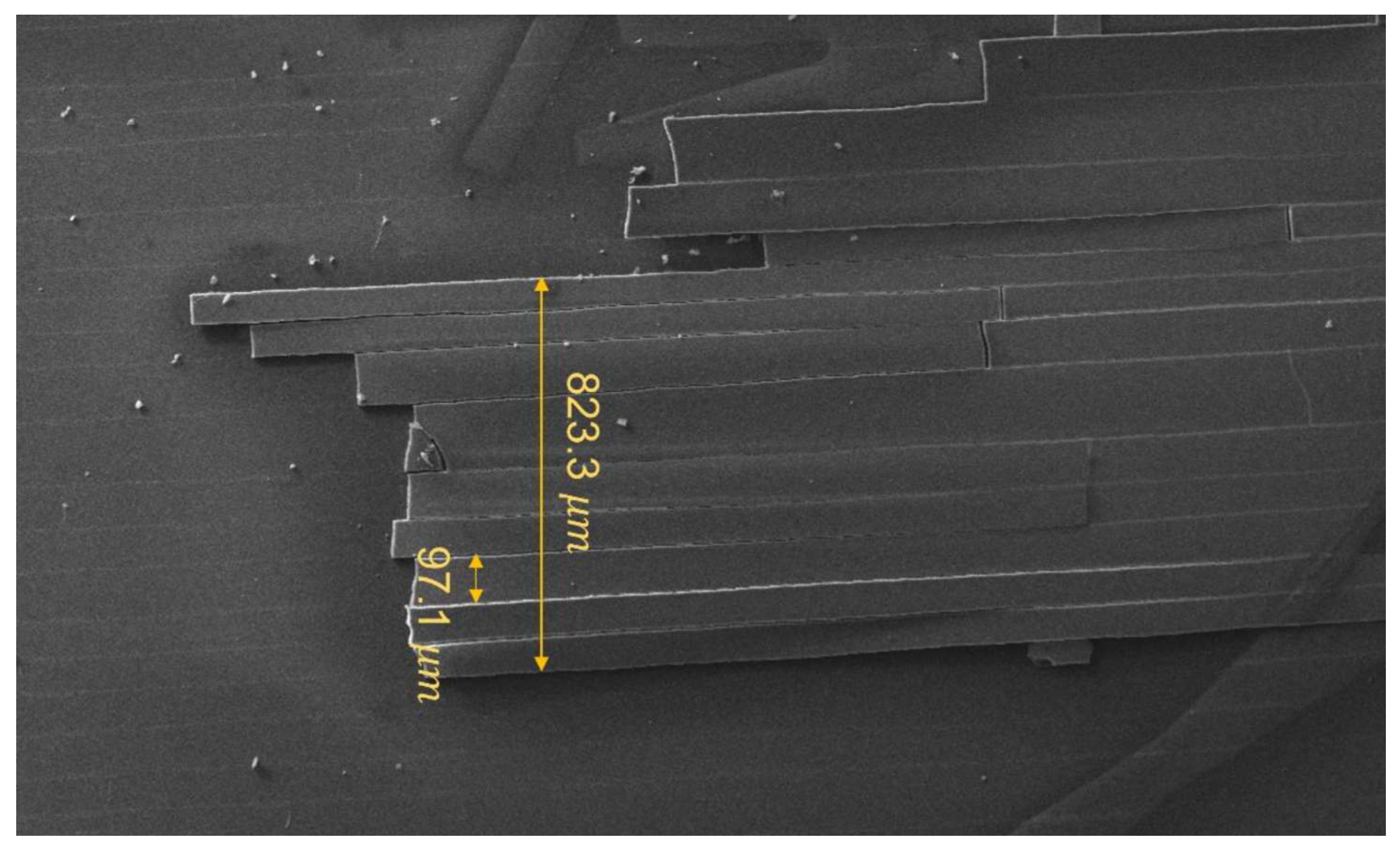
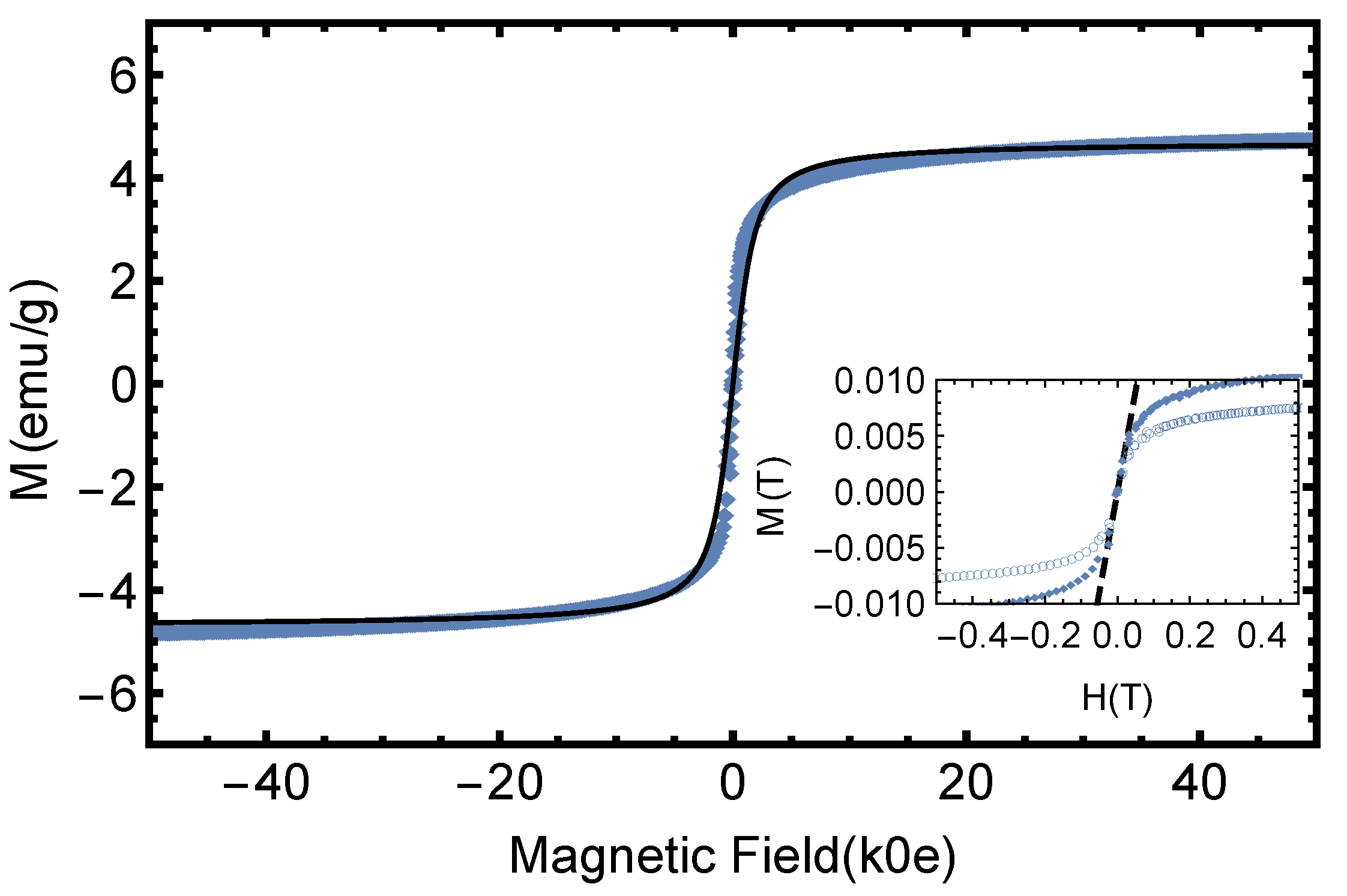
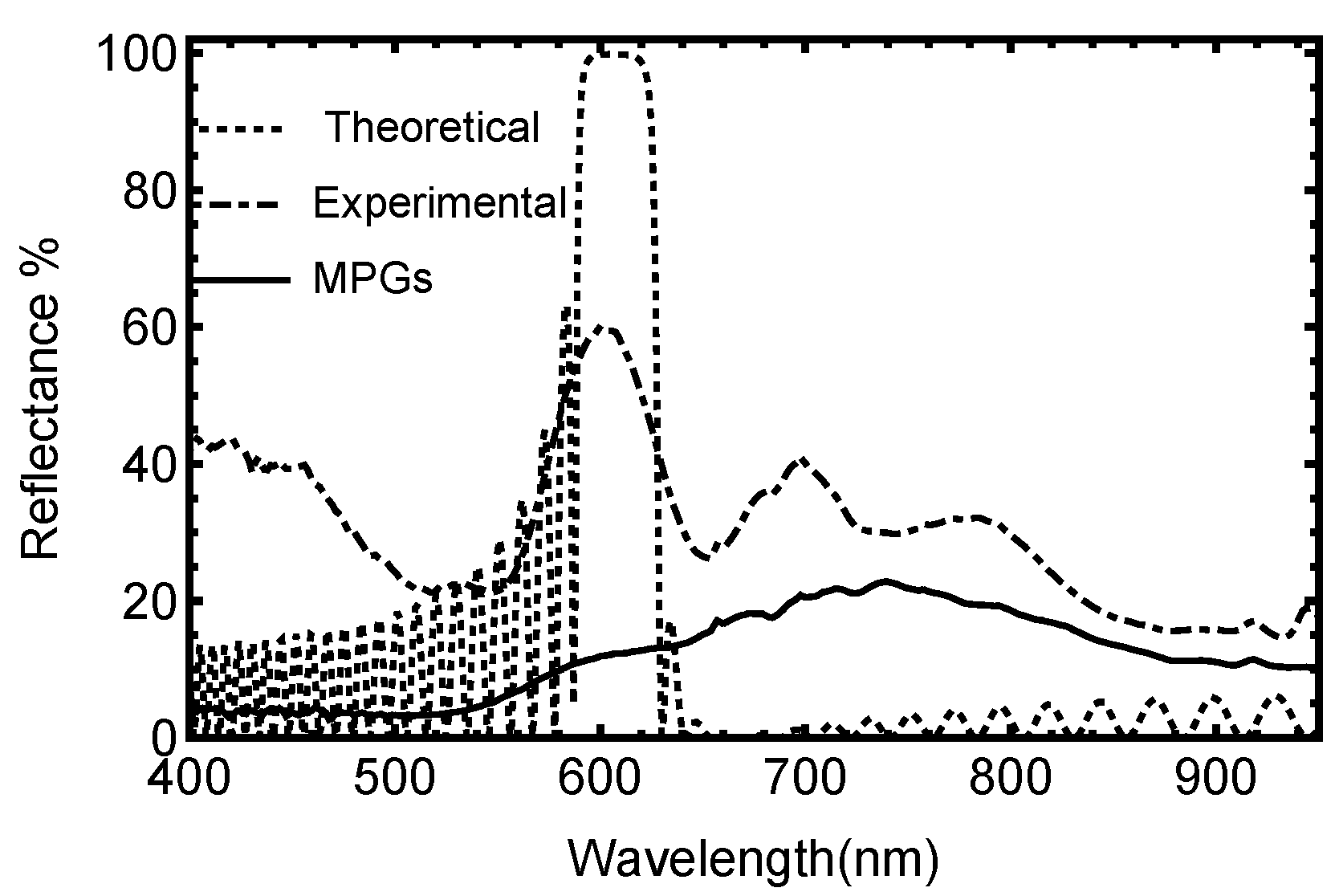
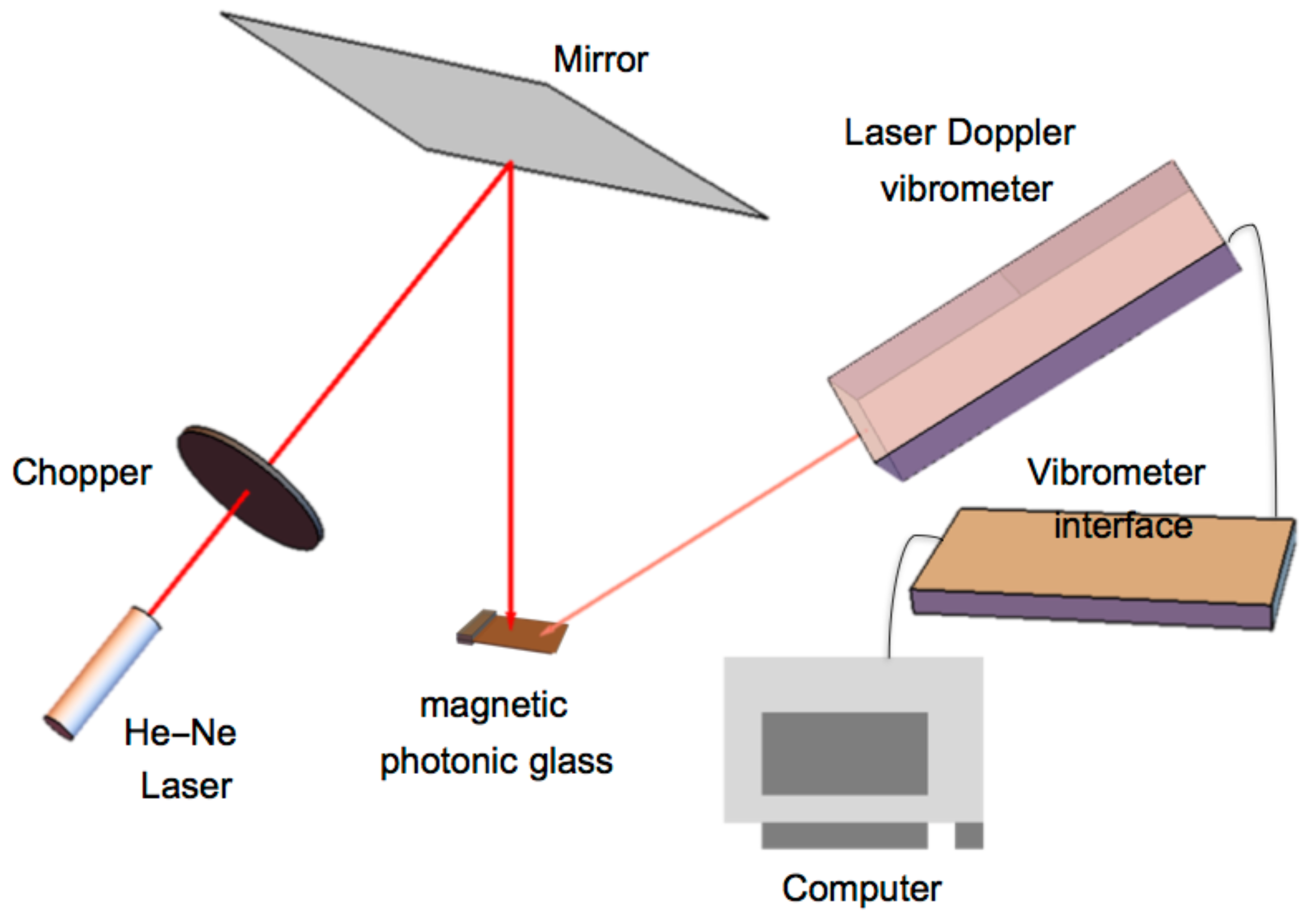

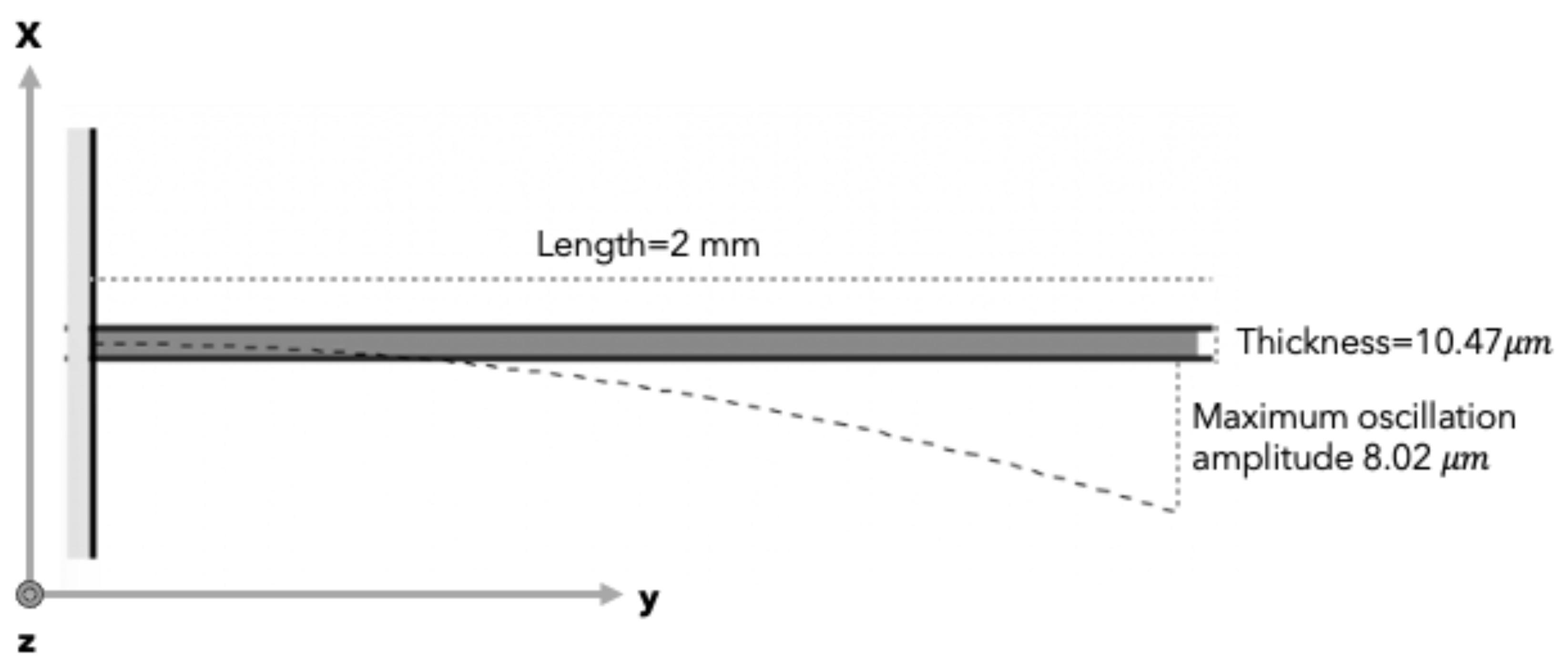

| Geometry | Material Properties | Constraints and Loads | Application Mode Parameters |
| Length of the beam: 2 mm. | The beam is considered | The left end | Default element type: |
| Width of the beam: 825 μm | linear and elastic with the | is fixed but the right end | Lagrange–Quadratic. |
| Thickness of the beam: 10.47 μm. | following properties: | end is free and | Analysis type: Static |
| The volume of the beam: 17.3 × 10−12 m3. | Young’s modulus: 55.34 GPa. | subjected to a distributed | |
| Density: 2030.67 kg/m3. | load W per m3. | ||
| Mesh Parameters | Solver Parameters | ||
| Mesh size: Normal. | Analysis: Harmonic propagation | ||
| Number of degrees | Solver: Stationary. | ||
| of freedom: 205,124. | Linear system solver: | ||
| Number of Mesh | Direct (UMFPACK). | ||
| points: 27,154. | Relative tolerance: 10−6 | ||
| Number of triangular | Maximum number of iterations: 25. | ||
| elements: 48,256. | |||
| Triangle base length: | |||
| 2.2 μm. | |||
| Triangle height: 1 μm. | |||
| Number of boundary | |||
| elements: 6048. | |||
| Number of vertex | |||
| elements: 8. | |||
| Minimum element | |||
| quality: 0.7056. | |||
| Element area ratio: 0.8030. |
Disclaimer/Publisher’s Note: The statements, opinions and data contained in all publications are solely those of the individual author(s) and contributor(s) and not of MDPI and/or the editor(s). MDPI and/or the editor(s) disclaim responsibility for any injury to people or property resulting from any ideas, methods, instructions or products referred to in the content. |
© 2024 by the authors. Licensee MDPI, Basel, Switzerland. This article is an open access article distributed under the terms and conditions of the Creative Commons Attribution (CC BY) license (https://creativecommons.org/licenses/by/4.0/).
Share and Cite
Avalos-Sánchez, H.; Carmona-Carmona, A.J.; Palomino-Ovando, M.A.; Desirena, B.F.; Palomino-Merino, R.; Misaghian, K.; Faubert, J.; Toledo-Solano, M.; Lugo, J.E. Increasing Light-Induced Forces with Magnetic Photonic Glasses. Photonics 2024, 11, 827. https://doi.org/10.3390/photonics11090827
Avalos-Sánchez H, Carmona-Carmona AJ, Palomino-Ovando MA, Desirena BF, Palomino-Merino R, Misaghian K, Faubert J, Toledo-Solano M, Lugo JE. Increasing Light-Induced Forces with Magnetic Photonic Glasses. Photonics. 2024; 11(9):827. https://doi.org/10.3390/photonics11090827
Chicago/Turabian StyleAvalos-Sánchez, Hugo, Abraham J. Carmona-Carmona, Martha A. Palomino-Ovando, Benito Flores Desirena, Rodolfo Palomino-Merino, Khashayar Misaghian, Jocelyn Faubert, Miller Toledo-Solano, and Jesus Eduardo Lugo. 2024. "Increasing Light-Induced Forces with Magnetic Photonic Glasses" Photonics 11, no. 9: 827. https://doi.org/10.3390/photonics11090827





